| Reviews & Columns |
|
Reviews DVD TV on DVD Blu-ray 4K UHD International DVDs In Theaters Reviews by Studio Video Games Features Collector Series DVDs Easter Egg Database Interviews DVD Talk Radio Feature Articles Columns Anime Talk DVD Savant Horror DVDs The M.O.D. Squad Art House HD Talk Silent DVD
|
DVD Talk Forum |
|
|
| Resources |
|
DVD Price Search Customer Service #'s RCE Info Links |
|
Columns
|
|
|
Doctor Who: The Space Museum/The Chase
BBC Worldwide // Unrated // July 6, 2010
List Price: $49.98 [Buy now and save at Amazon]
The Show:
Toward the end of its original run, Doctor Who was getting a bit formulaic. The stories were generally 4 or 6 episodes long, and followed a basic pattern: Doctor arrives, discovers something odd, investigates, rescues his companion, fights the APE (All Pervading Evil) and then leaves. There's nothing really wrong with that, it made for some entertaining adventures, but back in the early days of the show things weren't as settled. Stories could stretch over 12 episodes (Daleks' Master Plan) or only two (The Edge of Destruction), and there was more latitude in the stories. Case in point the BBC's latest R1 release of William Hartnell stories The Space Museum and The Chase. These two adventures mix things up a bit story wise, and include some unexpected story twists that are both fun and surprising. These also include the first appearance of a new companion and the fate of two others. It's a great set that fans of early Who will certainly want in their collections.
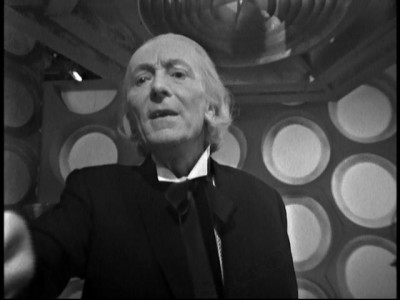
The
It's obvious that they have to change the future, but how? Every action they take could lead them closer to being a museum display or could save them. How do they know what events need to transpire for them to avoid their fate? While the group is on the run from the museum guards they also encounter a group of lads who are the rightful inhabitants of the planet. These young men have banded together and formed a small resistance group, but they aren't nearly ready to take on the guards. So how can they help The Doctor and his friends?
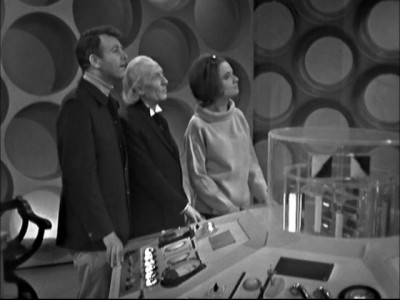
I really, really like this story. In one of the extras it's mentioned that this particular adventure isn't very popular with fans and I'm still astonished. Maybe it's because I look at things from a writer's point of view, but there were a lot of great plot points that served to keep viewers guessing, and some subtle comedy that really added a lot to the whole show.
When the travelers first land they find themselves in an incredibly interesting setting right in the middle of a bizarre mystery. That really starts the series rolling, but then there's a spanner thrown in the works. Like Hitchcock did in Psycho, the story takes an abrupt turn. By the end of the first episode it's not longer about why they can't be seen, but whether they're able to change the future even given the fact that they know what's going to happen. It seems like an easy task, but it turns out to be quite difficult.
Things don't work the way viewers think they will either, and I find that adds a nice light touch to the proceedings. At one point Ian notices that a button is missing from his coat, and the Doctor really finds that to be a very important clue, asking Ian exactly when he noticed it was missing. It's obvious that the button will play an important roll later on in the story except... that it's never mentioned again. Likewise, it's assumed from the beginning that the Doctor will be the one to concoct a plan that will allow them to survive, but that's not really what happens.
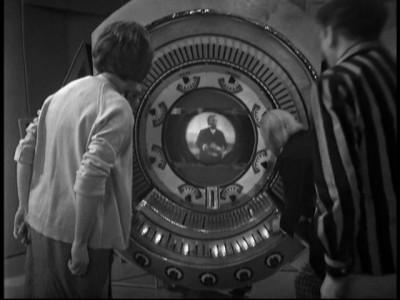
There's a lot of humor in the story too, but it's not over-the-top and broad like The Horns of Nimon. Yes, the Doctor does climb into a Dalek casing at one point, but it is brief and fun. The best parts are the inhabitants of the planet. The guards, members of a fierce military race are horribly inept. You'd expect crack troops to be guarding something so special, but they're incompetent bunglers right on up to the man in charge. The rebels are no better. They're like the People's Front of Judea in Monty Python's Life of Brian, sitting around holding meetings and making plans, but never actually doing anything.
This was the first time I've seen this adventure, and I thought it was great from beginning to end. With a lot of unexpected twists on the typical Who story, it'll keep viewers guessing, and smiling to themselves, the whole way through.
The Chase: This is another atypical Doctor Who story. Immediately after leaving the
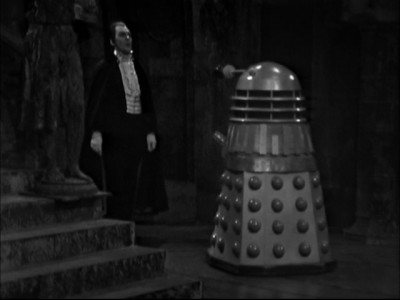
While Ian and Vicki go exploring, Barbra and the Doctor stay behind and relax. The Time-Space Visualiser was left on however and it pulls in a signal from the Daleks. The mechanical monsters are planning on attacking the Doctor. They have a lock on the TARDIS and are willing to follow him wherever he goes.
The first thing the Doctor does is try to find the missing members of his party, and promptly gets captured by the inhabitants of Aridis, a group of fish-like creatures, who are planning on turning over the traveler and his friends (now reunited) to the Daleks in exchange for them leaving the planet in peace. The Doctor escapes, naturally, tricks the Daleks away from the TARDIS, and the group is off zipping through time and space with the Daleks close behind.
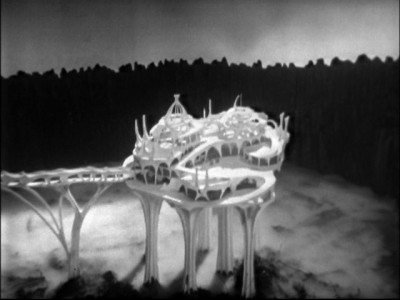
This was a great series too. At first it plays out like a typical adventure with the party getting split up and a threat being discovered. There is also a problem that needs to be solved: the native Aridius inhabitants are being attacked by monsters and have walled off parts of their underground cities to protect themselves. Most viewers watching for the first time probably assumed that the entire adventure would take place on Aridius with The Doctor ultimately protecting the fishmen from both the Daleks and the invading squid-creatures. Not so! As soon as he can the Doctor and company jump in the TARDIS and leave the duplicitous Aridians to their fate. The next chunck of the story has the group landing anywhere and everywhere. On a old wooden ocean vessel, the top of the
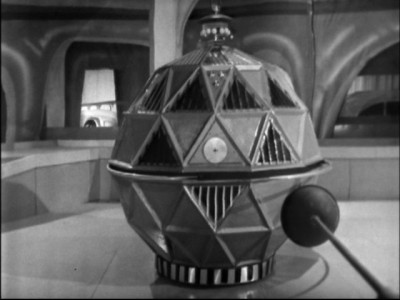
The story even ends with a great sequence that was touching. I won't ruin the surprise, but it was icing on the cake.
The DVD:
These two adventures arrive on three DVDs housed in a single-width keepcase. The first two discs contain the TV episodes with the third disc reserved for extras dealing with The Chase.
Audio:
This show comes with the original mono soundtrack that fits the show just fine. The dynamic range is nothing to write home about, but the dialog is generally crisp and clear and there is no background noise, tape hiss, distortion or dropouts. There are optional subtitles in English.
Video:
The full frame B&W image is very good, impressive even. The Restoration Team did their usual fine job and these stories, really making the most of what they had to work with (which wasn't a lot.) The image is nicely balanced and the definition and level of detail is very good. The contrast has been adjusted too to create a very pleasing image.
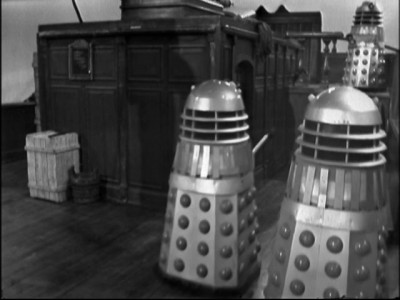
Extras:
This disc has some great extras included, as is the standard for Doctor Who releases. There is a commentary track for all episodes of both stories, with William Russell (Ian), Maureen O'Brien (Vicki), and writer Glyn Jones weighing in on The Space Museum and Maureen O'Brien (Vicki), William Russell (Ian), Peter Purves (Steven), and director Richard Martin commenting on The Chase. These are just about always enjoyable to listen to, and these commentary tracks are no exception.
Other featurettes include Defending the Museum: Re-evaluation by Robert Shearman (9 minutes) where the story is defended (though I don't think it needs to be), My Grandfather, the Doctor has William Hartnell's granddaughter reminisce about what she remembers of her ancestor, and A Holiday for the Doctor is a horrible, horrible, spoof hosted by a guy in drag. Watching this is something akin to slamming your hand in a car door, only more painful.
On the second disc devoted to The Chase there's also Cusik in Cardiff where the original designer of the Daleks visits the studio where the new series Daleks are being made, a making-of short, The Thrill of the Chase, Last Stop White City, a look at companions Barbara and Ian, and a retrospective on the Daleks, Daleks Conquer and Destroy. One of the bonus items I really enjoyed was a look at all of the Dalek merchandise that had been created over the years: Daleks Beyond the Screen. That's followed by another great documentary, Shawcraft-The Original Monster Makers, a look at the company who made props for Doctor Who (and many other productions.) A rare tour of the classic Shawcraft studios is given in Follow That Dalek, a 8mm amateur film that looks at many of the props (most of them Who related) that inhabited the studio in the 1960's. It's a very cool look at many great devices and models. And if that wasn't enough, there's a set of Give a Show Slides a kid's slide projector set that included 16 Doctor Who stories.
In addition there is a pop-up informational text option which is very informative as always. It does give some dry statistics, like how many people viewed each episode, but there are also some interesting notes such as script changes that were made and background information on the supporting characters. The extras are rounded off with, a couple of photo galleries, and the listings from the Radio Times in .pdf format.
Final Thoughts:
I really enjoyed both of these stories. It's obvious that the writers were trying to think outside the box on both of these and shake up the format a bit. The result is a pair of fun and interesting stories that are filled with unexpected twists and turns. The set is filled with a lot of high quality bonus features too and the image quality looks better than it has since these were first broadcast decades ago. Highly Recommended.
|
| Popular Reviews |
| Sponsored Links |
|
|
| Sponsored Links |
|
|
| Release List | Reviews | Shop | Newsletter | Forum | DVD Giveaways | Blu-Ray | Advertise |
|
Copyright 2024 DVDTalk.com All Rights Reserved. Legal Info, Privacy Policy, Terms of Use,
Manage Preferences,
Your Privacy Choices | |||||||












